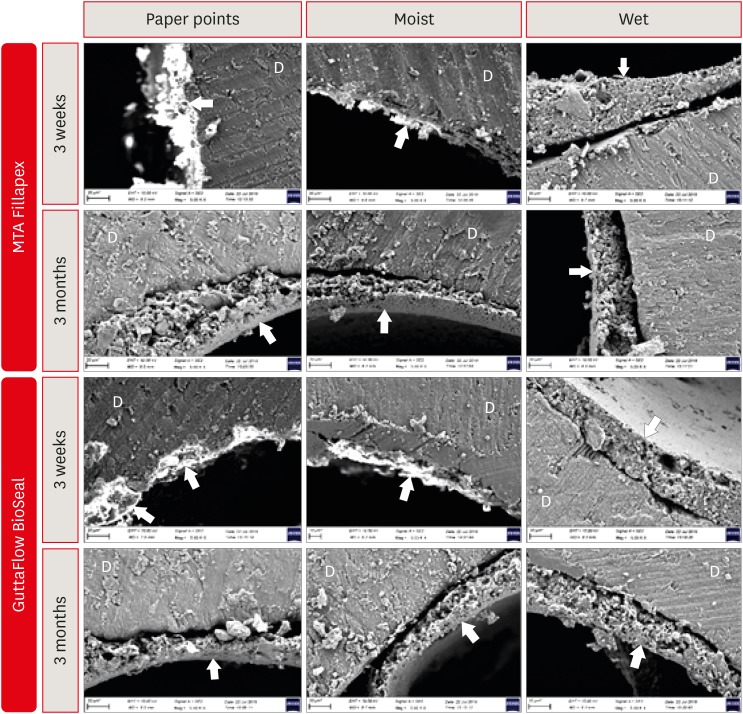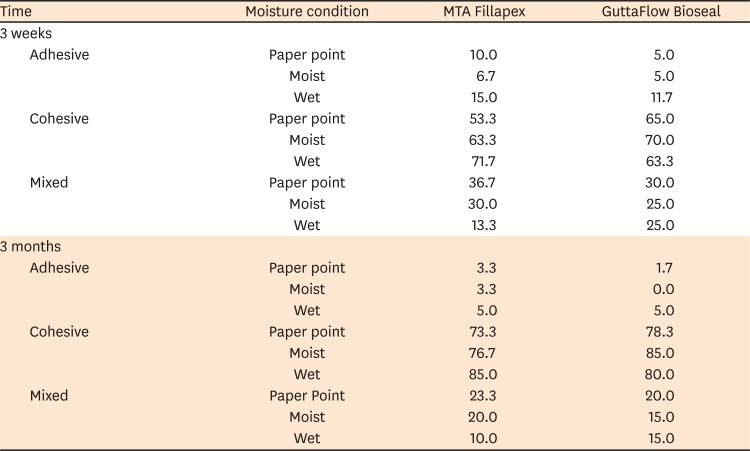1. Ng YL, Mann V, Rahbaran S, Lewsey J, Gulabivala K. Outcome of primary root canal treatment: systematic review of the literature - part 1. Effects of study characteristics on probability of success. Int Endod J. 2007; 40:921–939. PMID:
17931389.

2. Hülsmann M, Peters OA, Dummer PM. Mechanical preparation of root canals: shaping goals, techniques and means. Endod Topics. 2005; 10:30–76.
3. Nagas E, Uyanik MO, Eymirli A, Cehreli ZC, Vallittu PK, Lassila LV, Durmaz V. Dentin moisture conditions affect the adhesion of root canal sealers. J Endod. 2012; 38:240–244. PMID:
22244645.

4. Parirokh M, Torabinejad M. Mineral trioxide aggregate: a comprehensive literature review--Part I: chemical, physical, and antibacterial properties. J Endod. 2010; 36:16–27. PMID:
20003930.

5. Mandal P, Zhao J, Sah SK, Huang Y, Liu J.
In vitro cytotoxicity of GuttaFlow 2 on human gingival fibroblasts. J Endod. 2014; 40:1156–1159. PMID:
25069924.
6. Akcay M, Arslan H, Durmus N, Mese M, Capar ID. Dentinal tubule penetration of AH Plus, iRoot SP, MTA fillapex, and GuttaFlow BioSeal root canal sealers after different final irrigation procedures: a confocal microscopic study. Lasers Surg Med. 2016; 48:70–76. PMID:
26774730.

7. Razmi H, Bolhari B, Karamzadeh Dashti N, Fazlyab M. The effect of canal dryness on bond strength of bioceramic and epoxy-resin sealers after irrigation with sodium hypochlorite or chlorhexidine. Iran Endod J. 2016; 11:129–133. PMID:
27141222.
8. Ayad MF, Farag AM, Garcia-Godoy F. Effect of lactic acid irrigant on shear bond strength of Epiphany adhesive sealer to human dentin surface. Oral Surg Oral Med Oral Pathol Oral Radiol Endod. 2010; 109:e100–e106. PMID:
20416513.

9. Zmener O, Pameijer CH, Serrano SA, Vidueira M, Macchi RL. Significance of moist root canal dentin with the use of methacrylate-based endodontic sealers: an
in vitro coronal dye leakage study. J Endod. 2008; 34:76–79. PMID:
18155498.
10. Reddy P, Neelakantan P, Sanjeev K, Matinlinna JP. Effect of irrigant neutralizing reducing agents on the compromised dislocation resistance of an epoxy resin and a methacrylate resin-based root canal sealer in vitro
. Int J Adhes Adhes. 2018; 82:206–210.
11. Gancedo-Caravia L, Garcia-Barbero E. Influence of humidity and setting time on the push-out strength of mineral trioxide aggregate obturations. J Endod. 2006; 32:894–896. PMID:
16934637.

12. Dias KC, Soares CJ, Steier L, Versiani MA, Rached-Júnior FJ, Pécora JD, Silva-Sousa YT, de Sousa-Neto MD. Influence of drying protocol with isopropyl alcohol on the bond strength of resin-based sealers to the root dentin. J Endod. 2014; 40:1454–1458. PMID:
25146032.

13. Paula AC, Brito-Júnior M, Araújo CC, Sousa-Neto MD, Cruz-Filho AM. Drying protocol influence on the bond strength and apical sealing of three different endodontic sealers. Braz Oral Res. 2016; 30:e50.

14. Zhong X, Shen Y, Ma J, Chen WX, Haapasalo M. Quality of root filling after obturation with gutta-percha and 3 different sealers of minimally instrumented root canals of the maxillary first molar. J Endod. 2019; 45:1030–1035. PMID:
31182216.

15. Barbosa-Ribeiro M, Arruda-Vasconcelos R, Fabretti FL, Silva EJNL, De-Deus G, Gomes BPFA. Evaluation of apically extruded debris using positive and negative pressure irrigation systems in association with different irrigants. Braz Dent J. 2018; 29:184–188. PMID:
29898066.

16. Silva EJNL, Carvalho CR, Belladonna FG, Prado MC, Lopes RT, De-Deus G, Moreira EJL. Micro-CT evaluation of different final irrigation protocols on the removal of hard-tissue debris from isthmus-containing mesial root of mandibular molars. Clin Oral Investig. 2019; 23:681–687.

17. Khalil MM, Abdelrahman MH, El-Mallah S. Bond strength and solubility of a novel polydimethylsiloxane-gutta-percha calcium silicate-containing root canal sealer. Dent Med Probl. 2019; 56:161–165. PMID:
31274254.

18. Reyes-Carmona JF, Felippe MS, Felippe WT. The biomineralization ability of mineral trioxide aggregate and Portland cement on dentin enhances the push-out strength. J Endod. 2010; 36:286–291. PMID:
20113792.

19. Neelakantan P, Ahmed HM, Wong MC, Matinlinna JP, Cheung GS. Effect of root canal irrigation protocols on the dislocation resistance of mineral trioxide aggregate-based materials: a systematic review of laboratory studies. Int Endod J. 2018; 51:847–861. PMID:
29377170.

20. Neelakantan P, Grotra D, Sharma S. Retreatability of 2 mineral trioxide aggregate-based root canal sealers: a cone-beam computed tomography analysis. J Endod. 2013; 39:893–896. PMID:
23791258.








 PDF
PDF Citation
Citation Print
Print



 XML Download
XML Download